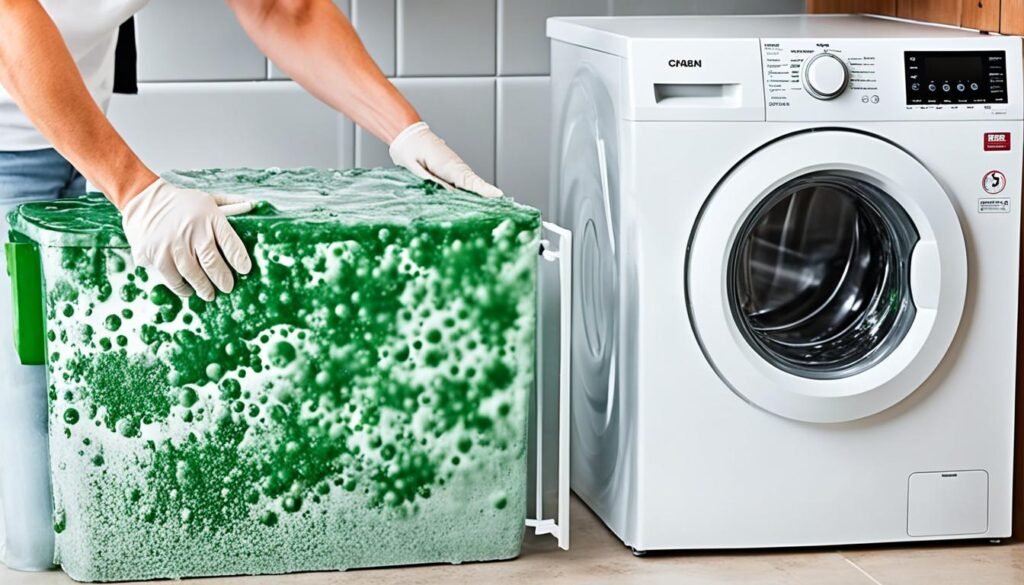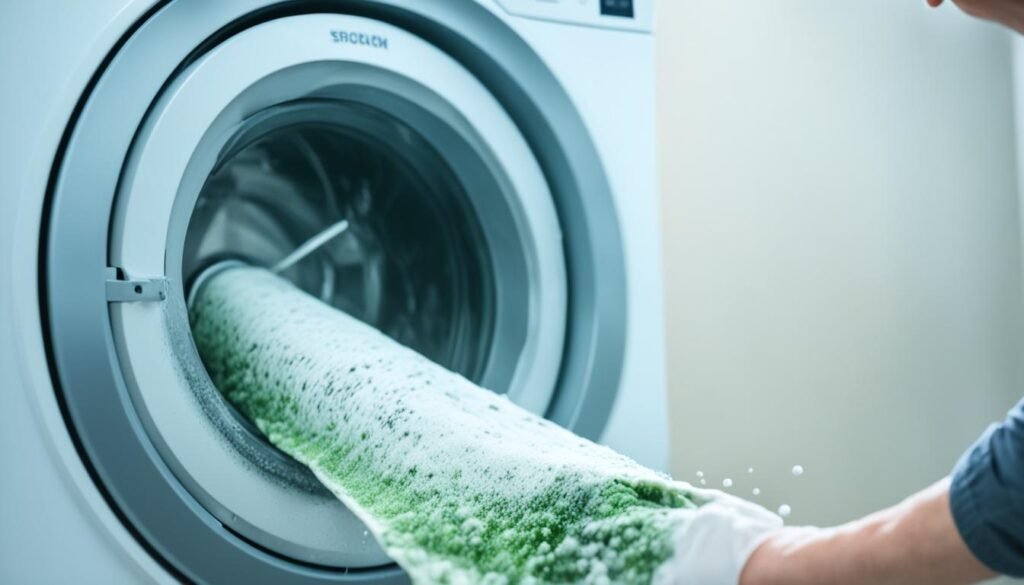Did you know that your washing machine can be a breeding ground for mold and mildew? In fact, studies have shown that up to 60% of washing machines harbor mold and bacteria, leading to unpleasant odors and potential health risks. Regular cleaning of your washing machine is essential for removing mildew and ensuring a hygienic laundry environment.
Over time, bacteria and mold can accumulate in the drum, filter, and door seal of your washing machine, compromising its performance and leaving your clothes smelling less than fresh. By following a few simple steps, you can effectively clean your washing machine and prevent mold growth.
- Cleaning your washing machine thoroughly is crucial for removing mold and mildew.
- Bacteria and mold can accumulate in the drum, filter, and door seal, affecting the machine’s performance and resulting in unpleasant odors.
- Regular maintenance, such as keeping the door open and using the recommended amount of detergent, can help prevent mold and mildew growth.
- Vinegar and bleach are effective cleaning agents for removing bacteria and mold from your washing machine.
- By incorporating regular cleaning and maintenance into your laundry routine, you can enjoy a fresh and mold-free washing machine.
The Best Way to Clean a Washing Machine
When it comes to deep cleaning your washing machine and ensuring proper laundry appliance maintenance, following the right steps is essential. Not only does it help control mold and mildew, but it also ensures that your machine performs optimally and keeps your laundry fresh and clean.
The first step in cleaning your washing machine effectively is to run an empty cycle with hot water. This helps to remove any dirt, residue, and bacteria that may have accumulated over time. To enhance the cleaning process, consider using a specialized washing machine cleaning product or a mixture of vinegar and baking soda.
Once you’ve run the empty cycle, it’s important to clean the exterior of the machine as well. Wipe down the outer shell using a damp cloth to remove any dust, stains, or spills. Pay special attention to the rubber door seal, as this area is prone to harboring bacteria and residue.
In addition to the exterior, don’t forget to clean the detergent drawer and the filter. These areas can accumulate detergent buildup, lint, and other debris, which can lead to mold and mildew growth if not addressed regularly. Remove the detergent drawer and clean it thoroughly with warm water and a mild detergent. As for the filter, consult your machine’s manual for specific instructions on how to clean it properly.
Regular maintenance is crucial in preventing mold and mildew. After each use, make it a habit to keep the door open to allow air circulation and moisture evaporation. This helps to create an environment that is less favorable for mold growth. Additionally, always use the recommended amount of detergent to avoid excessive residue buildup.
By following these steps and incorporating regular maintenance into your laundry routine, you can ensure a deep-cleaned washing machine, effective mold and mildew control, and a laundry appliance that keeps your clothes fresh and clean.
How to Clean a Washing Machine with Vinegar
Vinegar is a natural and effective cleaning solution for your washing machine. Not only is it eco-friendly, but it is also a cost-effective method that can help maintain the cleanliness and performance of your appliance. Follow these simple steps to clean your washing machine using vinegar:
- Mix two cups of white distilled vinegar with 1/4 cup of baking soda and 1/4 cup of water.
- Pour the mixture into the detergent container of your washing machine.
- Pour vinegar directly into the drum of the machine.
- Run a hot cycle to break up mineral deposits and remove mold growth. This will also help eliminate any unpleasant odors.
- After the cycle is complete, use a sponge scourer to clean the rubber door seal and wipe down the drum with fresh water.
This natural cleaning method is not only effective but also eliminates the need for harsh chemicals. Vinegar acts as a natural disinfectant and helps remove stubborn stains and build-up. By incorporating vinegar into your cleaning routine, you can promote a hygienic and fresh laundry environment.

Benefits of Cleaning with Vinegar
Using vinegar as a cleaning solution offers several benefits:
- Natural and Non-Toxic: Vinegar is a natural and non-toxic cleaning agent, making it safe for you and the environment.
- Economical: Vinegar is an affordable cleaning solution that can save you money on expensive commercial cleaning products.
- Eco-Friendly: By using vinegar, you reduce your reliance on harsh chemicals, contributing to a greener and more sustainable lifestyle.
- All-Purpose Cleaner: Vinegar is versatile and can be used to clean various household surfaces, not just your washing machine.
- Effective Against Bacteria and Mold: Vinegar has antimicrobial properties that help kill bacteria and prevent the growth of mold and mildew.
So, the next time your washing machine needs a deep clean, reach for vinegar and experience the benefits of this natural cleaning method.
How to Clean a Washing Machine with Bleach
Bleach can be a powerful tool for deep cleaning your washing machine and maintaining its performance. However, it’s important to check your machine’s manual first to ensure that it is safe to use bleach. Once you’ve confirmed its compatibility, follow these steps to effectively clean your machine:
- Clean the filter and gasket: Start by removing the filter and gasket of your washing machine. These areas are prone to buildup and should be thoroughly cleaned before proceeding.
- Add bleach to the drum and detergent drawer: Measure half a cup of bleach and add it directly into the drum of your washing machine. Pour the remaining bleach into the detergent drawer.
- Run an empty hot wash cycle: Start a hot wash cycle without any clothes in the machine. This will allow the bleach to penetrate and disinfect the entire drum.
- Pause the cycle if possible: If your washing machine has a pause or soak function, pause the cycle for an hour to allow the bleach to work its magic.
- Finish with an extra rinse: Once the pause is complete or if your machine doesn’t have a pause function, let the cycle run until the end. Then, run an additional rinse cycle to ensure all bleach residue is removed.
- Wipe down the door and seals: Use a clean cloth or sponge to wipe down the door and rubber seals of your washing machine. This will remove any bleach residue and prevent potential damage.
- Allow the machine to dry: Before using your washing machine again, make sure to dry the door and rubber seals thoroughly. This will prevent any moisture buildup and the growth of mold or mildew.
By following these steps, you can deep clean your washing machine using bleach and maintain its optimal performance. Remember to always prioritize safety and refer to your machine’s manual for specific instructions.

| Bleach Cleaning Method | |
|---|---|
| Pros |
|
| Cons |
|
Conclusion
Keeping your washing machine clean and free of mildew is crucial for maintaining its performance and ensuring fresh and clean laundry. By regularly cleaning your machine and following the recommended steps, you can eliminate mildew, prevent mold growth, and enjoy a thoroughly cleaned washing machine.
Whether you choose to clean your washing machine with vinegar or bleach, both methods are effective in eliminating bacteria and mold that can lead to unpleasant odors and mold-related issues. Vinegar offers a natural and eco-friendly cleaning solution, while bleach provides a deep clean for more stubborn stains and buildup.
In addition to deep cleaning, incorporating regular maintenance tasks into your laundry routine is essential for mold prevention. Keep the door of your washing machine open after use to allow air circulation and dry out any moisture. Use the recommended amount of detergent and clean the filter and detergent drawer to avoid residue buildup.
By following these tips and maintaining a clean and mold-free washing machine, you can ensure optimal performance and enjoy fresh and clean laundry every time.
FAQ
How often should I clean my washing machine?
It is recommended to clean your washing machine at least once every month to prevent the growth of mildew and maintain its performance.
What should I use to clean my washing machine?
You can use a washing machine cleaning product, vinegar, or bleach to thoroughly clean your machine and remove bacteria and mold.
Can I use vinegar to clean my washing machine?
Yes, vinegar is a natural and effective cleaning solution for your washing machine. You can mix two cups of white distilled vinegar with 1/4 cup of baking soda and 1/4 cup of water, then run a hot cycle to remove mineral deposits and mold growth.
Is bleach safe to use for washing machine cleaning?
Before using bleach, check your washing machine’s manual to ensure it is safe. If it is, you can add half a cup of bleach directly into the drum and half into the detergent drawer, then run an empty hot wash cycle.
How can I prevent mildew from growing in my washing machine?
To prevent mildew, make sure to keep the door open after each use, use the recommended amount of detergent, and perform regular maintenance, such as cleaning the filter and gasket.
